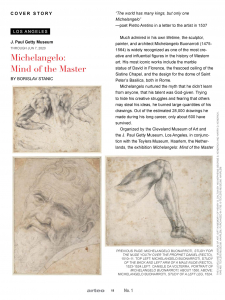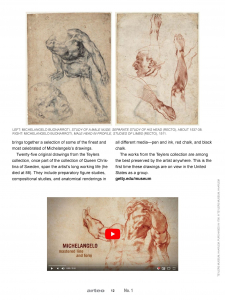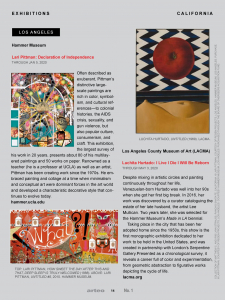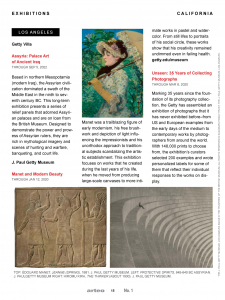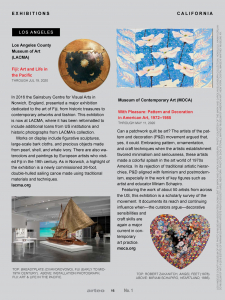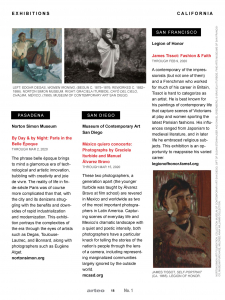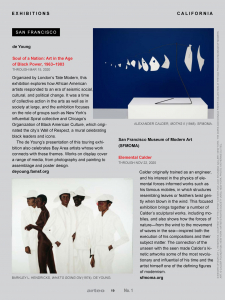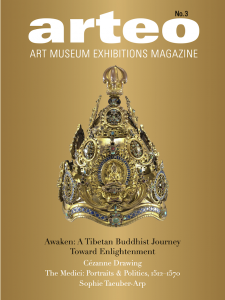
In This Issue
- COVER STORY: Michelangelo: Mind of the Master—J. Paul Getty Museum, Los Angeles
- This exhibition of nearly 30 drawings by the Renaissance master is a rare chance to see his works on paper and witness a key part of his creative process up close. The drawings on display (mainly from the Teylers Museum, Haarlem, the Netherlands) include studies for his paintings on the ceiling of the Sistine Chapel and his epic Last Judgment.
- FEATURE: Leonardo da Vinci—Musée du Louvre, Paris
- The 500th anniversary of Leonardo da Vinci’s death is an ideal time to become reacquainted with the Renaissance man’s work. The Louvre holds the largest collection of Leonardo paintings in the world and this exhibition demonstrates the high regard with which Leonardo held the art of painting and how he investigated the world through this medium.
- FEATURE: Raphael 1520–1483—Scuderie del Quirinale, Rome
- The achievements that Raphael packed into his short life (he died at the age of 37) are amply revealed in this blockbuster exhibition. Marking 500 years since his death, the exhibition traces his career through 204 works, fully presenting the vast creative triumphs of the artist—from painting to decorative arts, from architecture to town planning.
- Fiji: Art and Life in the Pacific—Los Angeles County Museum of Art (LACMA)
- This major exhibition is dedicated to the art of Fiji, from historic treasures to contemporary artworks and fashion. Works on display include figurative sculptures, large-scale bark cloths, and precious objects made from pearl, shell, and whale ivory.
- Lari Pittman: Declaration of Independence—Hammer Museum, Los Angeles
- Often described as exuberant, Pittman’s distinctive large-scale paintings are rich in color, symbolism, and cultural references—to colonial histories, the AIDS crisis, sexuality, and gun violence, but also popular culture, consumerism, and craft.
- With Pleasure: Pattern and Decoration in American Art, 1972–1985—Museum of Contemporary Art (MOCA), Los Angeles
- Can a patchwork quilt be art? The artists of the P&D movement argued that, yes, it could. Embracing pattern, ornamentation, and craft techniques when the artistic establishment favored minimalism and seriousness, these artists made a colorful splash in the art world of 1970s America.
- Soul of a Nation: Art in the Age of Black Power, 1963–1983—de Young, San Francisco
- This exhibition explores how African American artists responded to an era of seismic social, cultural, and political change. The exhibition focuses on the role of groups such as New York’s influential Spiral Collective and Chicago’s Organization of Black American Culture.
- Verrocchio: Sculptor and Painter of Renaissance Florence—National Gallery of Art, Washington, DC
- Verrocchio was an innovative artist and teacher whose pupils included Leonardo da Vinci, Pietro Perugino, and likely Sandro Botticelli. The exhibition examines the wealth and breadth of Verrocchio’s extraordinary artistry and how his work in each art form stimulated creativity in the others.
- El Greco—Art Institute of Chicago
- With more than 57 works from all over the world, this major retrospective traces the development of El Greco’s distinctive artistic signature and reveals the ambitious artist driven to achieve professional success.
- Ernst Ludwig Kirchner—Neue Galerie, New York
- Kirchner was one of the most significant German artists of the 20th century, a founding member of Die Brücke art movement. This exhibition focuses on Kirchner’s influence on the development of German expressionism.
- Félix Fénéon: The Anarchist and the Avant-Garde—From Signac to Matisse and Beyond—The Museum of Modern Art (MoMA), New York
- One of the most intriguing figures in the art world of Belle Epoque Paris, Félix Fénéon was an art critic, publisher and dealer whose support was critical to the careers of key artists of the avant-garde.
- Cezanne and the Master Painters: A Dream of Italy—Musée Marmottan Monet, Paris
- This exhibition shows how profoundly influenced Cezanne was by Italian art of the 16th and 17th centuries. The exhibition also examines the influence of Cezanne on later Italian artists, such as Morandi and Boccioni.
- Striking Iron: The Art of African Blacksmiths—Musée du Quai Branly-Jacques Chirac, Paris
- The countries of sub-Saharan Africa have some of the most important iron blacksmithing traditions in the world. This comprehensive exhibition brings together 230 pieces that represent the huge diversity of forms and traditions associated with iron.
- Making Van Gogh: A German Love Story—Städel Museum, Frankfurt
- Linking more than 120 paintings and works on paper, this show focuses on the creation of the “legend of Van Gogh” around 1900 as well as his importance to the modern art movement in Germany.
- Van Dyck—Alte Pinakothek, Munich
- For this exhibition the Alte Pinakothek drew from its extensive trove of works by Flemish master Anthony van Dyck, known for his portraits of au courant figureheads—nobles, military, legendary stunners, as well as historical works and religious scenes.
- Tiepolo: The Best Painter in Venice—Staatsgalerie Stuttgart
- As the first show in the German-speaking world to focus on Tiepolo’s entire career, the exhibition succeeds with a thorough look at his oeuvre—from historical subjects to moving religious paintings to drawings and etchings.
- Pietro Aretino and the Art of the Renaissance—Galleria degli Uffizi, Florence
- Aretino—author, playwright, satirist, and more—was a man of his times, fully immersed in the society and culture of one of the most significant periods of Italian history. This exhibition traces Aretino’s life and work through paintings, sculptures, tapestries, and other works.
- Gio Ponti: Loving Architecture—MAXXI Museo Nazionale delle arti del XXI secolo, Rome
- The Italian architect Ponti was a key figure in the history of 20th-century design, his multi-disciplinary practice spanning interiors and furniture, urban planning and publishing (as a writer and as a founder of the long-running magazine Domus).
- Caravaggio–Bernini: Baroque in Rome—Rijksmuseum, Amsterdam
- It’s no surprise that Caravaggio and Bernini are the stars of this exhibition showcasing the paintings and sculpture of early 17th-century Rome, but the 70 pieces on display also include masterpieces from their contemporaries and followers.
- The Impressionists and Photography—Thyssen-Bornemisza Museo Nacional, Madrid
- This exhibition looks at the many affinities between painting and photography in 19th-century Europe, covering a variety of pictorial subjects, as practitioners in both disciplines sought to capture the rapidly modernizing world around them in fresh and experimental ways.
- Troy: Myth and Reality—British Museum, London
- Did the ancient city of Troy really exist, or was it a figment of Homer’s imagination? What is it about the legend of the city and its fall that has intrigued and enthralled audiences for more than 3,000 years? These are the two central strands of this major exhibition.
- Andy Warhol—Tate Modern, London
- This major retrospective of the pop artist, director, and all-around cultural phenomenon draws on recent scholarship and presents work from throughout his career. The exhibition examines the social, cultural, and political context of Warhol’s practice.
- Gauguin Portraits—National Gallery, London
- The first exhibition dedicated to Gauguin’s portraits, this show brings together around 50 works that range from self-portraits to depictions of ordinary people. As one of the most influential artists of postimpressionism, Gauguin used portraiture to develop his ideas about art and also to self-mythologize.
- Tutankhamun: Treasures of the Golden Pharaoh—Saatchi Gallery, London
- Egyptian authorities have vowed that this exhibition—currently on the London leg of a world tour—is the last time these treasures from Tutankhamun’s tomb will be seen outside Egypt. Audiences can gaze upon 150 dazzling objects from his tomb, 60 of which have never traveled before.
- William Blake—Tate Britain, London
- Blake is arguably more famous as a radical poet than as an artist, his visionary verse having resonated far beyond his death. This major exhibition puts the emphasis on his painted, drawn, and etched output, and seeks to position him as a visual artist for the 21st century.
- DESTINATION: Hudson Yards, New York
- Only in New York could it be possible to imagine a brand new neighborhood eked out of a bustling metropolis. Perched atop the city’s rail yards, Hudson Yards is the largest, most expensive real estate development in the city’s history. The area is a haven of art and culture with headline-worthy attractions and hidden gems.
About Arteo Magazine
Arteo Magazine helps art lovers discover, explore, and enjoy art to the fullest via stunning photography, video and audio content.
Arteo Magazine is an essential guide for art lovers looking to narrow down a list of their must-see exhibitions. Save hours of research and read it before you plan your next visit.
Whether you intend a physical visit to a museum to experience art in person, or you seek to access a museum’s content online, our carefully curated selections will be your companion to the best art exhibitions around the globe.
With so many dazzling international art exhibitions to choose from, we hope that this selection will give you the insights and inspiration to enhance your visitor experience.
Category:
Publisher: Arteo Magazine
Published: Quarterly
Language: English
Compatibility: iOS/Android App + Web Reader
